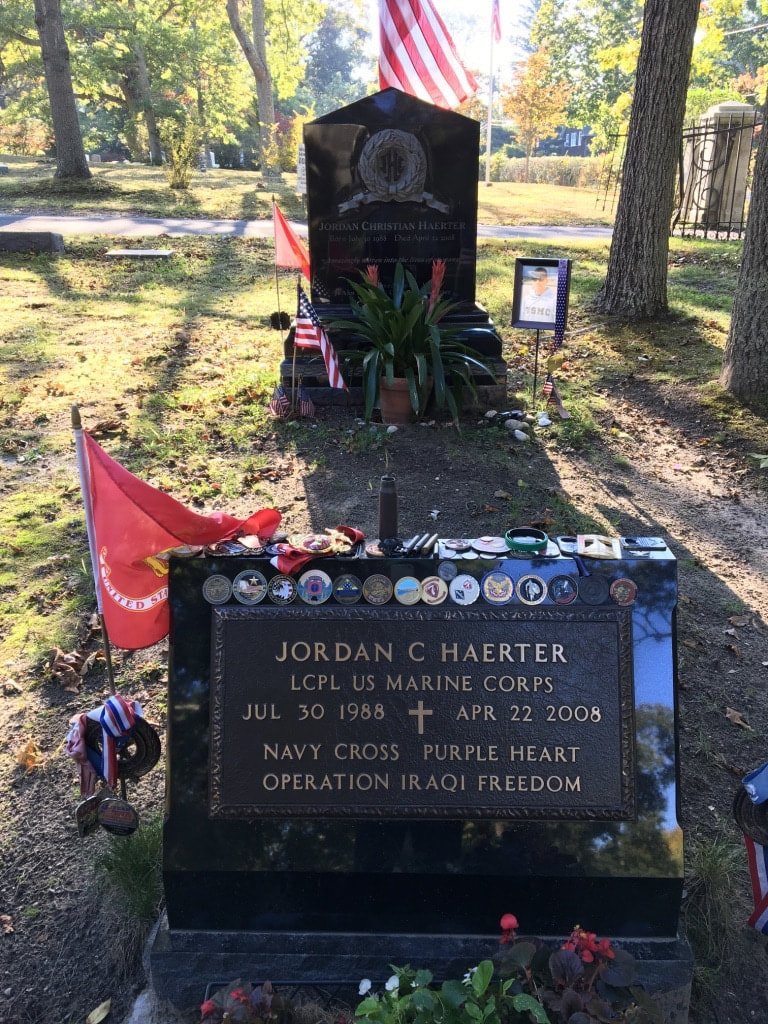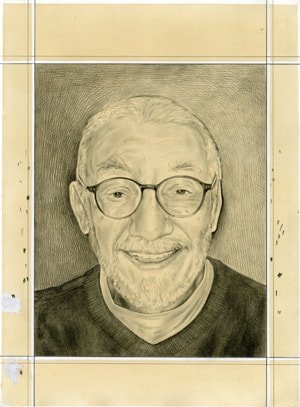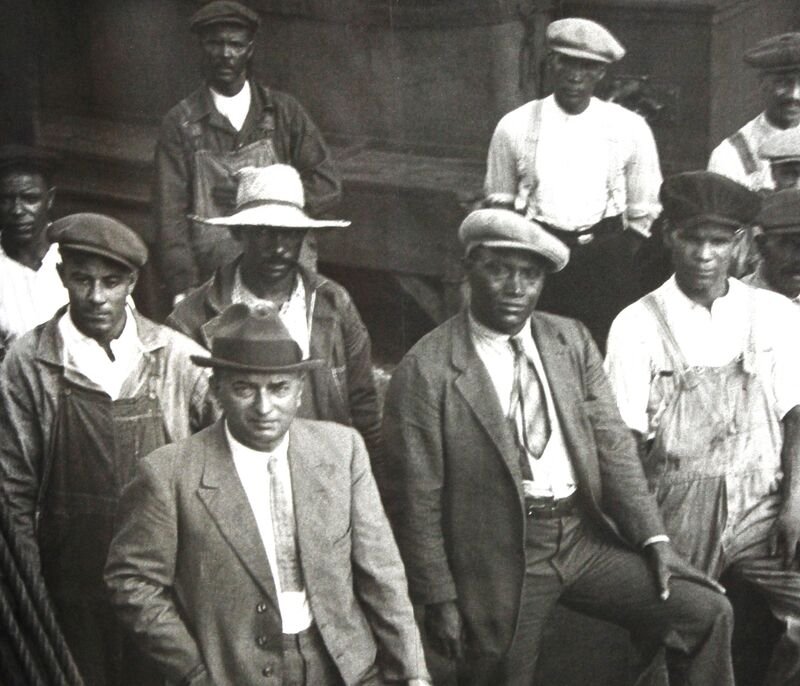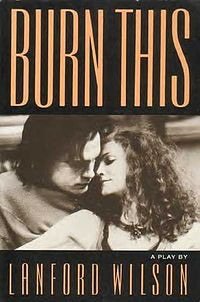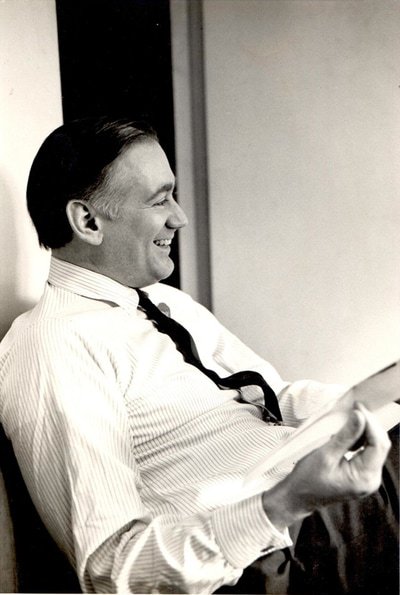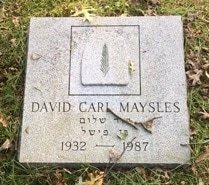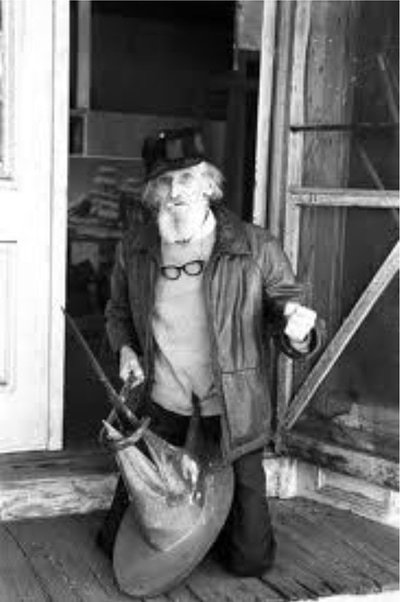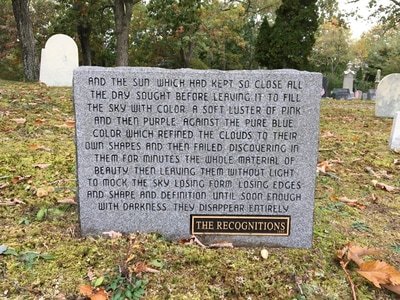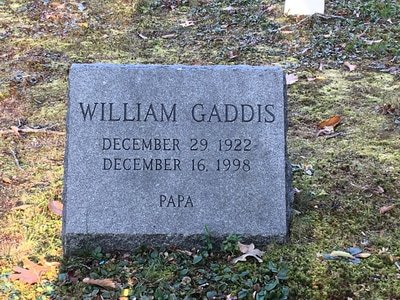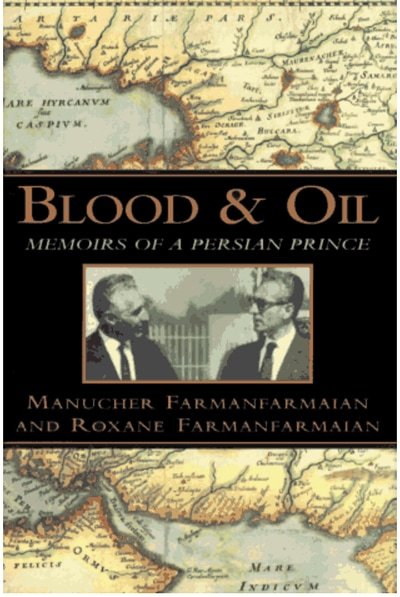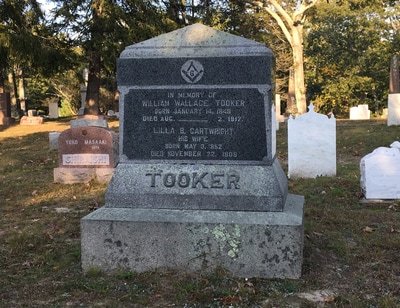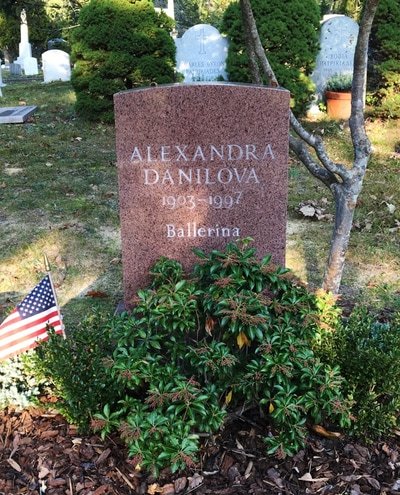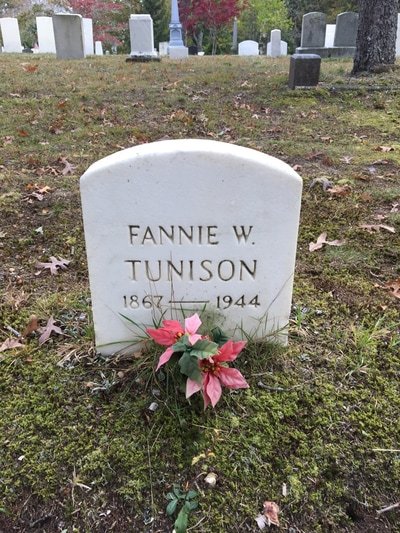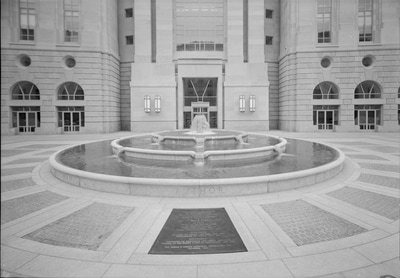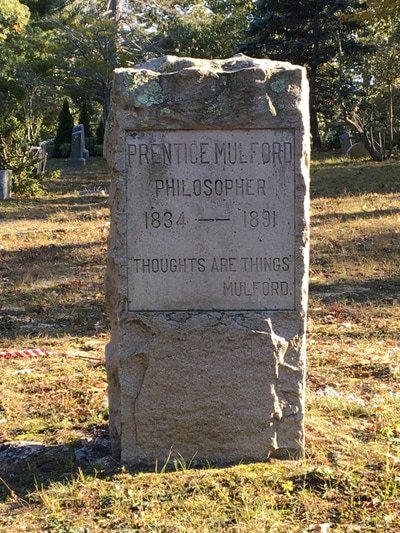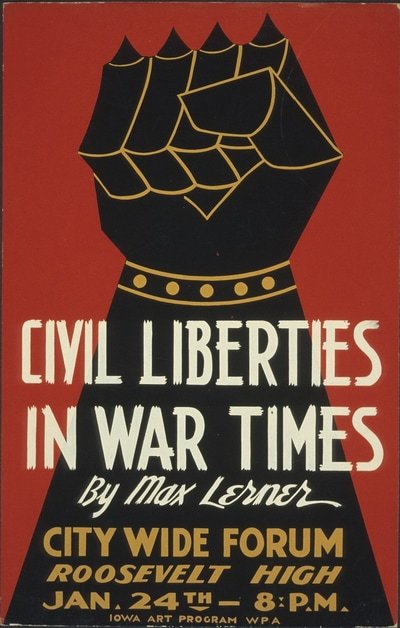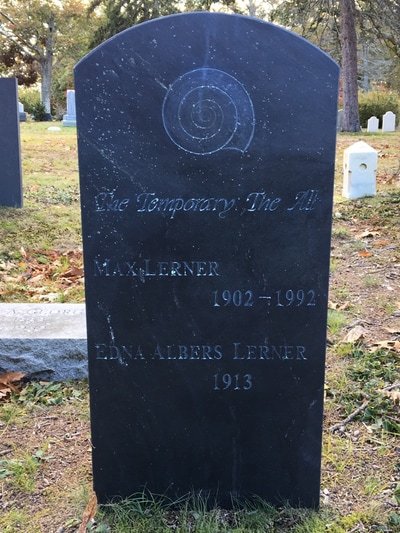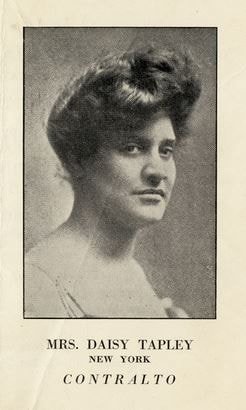PERMANENT RESIDENTS OF OAKLAND CEMETERY
Oakland Cemetery, located at Jermain St. and Palmer Terrace, was founded in 1840 and occupies 26 acres. It is the permanent resting place of over 4,000 people, including sea captains, artists, writers, musicians, and people of every race and ethnicity, including two Iranian princes, a Native American Queen, and ballet master George Balanchine. It truly reflects the diversity and history of our unique Village.
Originally, Oakland Cemetery was just 4 acres, but 139 graves from the Old Burying Ground at Union and Madison were moved to Oakland when it was expanded to include what had been the Oakland Brass Foundry and Clock Works around 1850, and later to include Ephraim Byram’s clock making and astronomy business. Its last business, in 1880, was the Oakland Hat Manufactory. Two years after that business failed in 1882, its old wooden structures burned to the ground. The site was purchased by Joseph Fahys of Fahys Watchcase Factory and Stephen French, who donated the land to the cemetery.
In September 1884 the Oakland Cemetery Association expanded it further, and in 1903 the Ladies Village Improvement Society unveiled its new memorial gate, at its main entrance.
Many of those involved in the cemetery’s creation are buried here, including Fahys and Ephraim Byram, Benjamin Huntting, who built what is now the Sag Harbor Whaling Museum and had been a captain of the whaling industry.
Our tour will start at the main entrance, and continue past Fahy’s Mausoleum on the left to the first aisle on the right facing the cemetery.
We have culled much information for this tour from Wikipedia, and are indebted to Ken Yardley of Yardley & Pino Funeral Home for his input. Sag Harbor Partnership also gratefully acknowledges the great volunteer work of Edmund Hollander of Edmund Hollander Landscape Associates, who took it upon himself to organize an extensive clean-up of the trees and shrubs that grace the cemetery in 2015 with the help of generous local landscapers.
Please scroll to the bottom for maps. Or download: OAKLANDMAP.pdf
-
THE YEAR WITHOUT A SUMMER
-
THE SAG-HARBOR FIRES OF 1817 AND 1845
-
THE FIRES THAT ENDED THE DEPRESSION
-
THE GREAT WHITE HURRICANE: THE BLIZZARD OF 1888
-
THE GREAT FIRES OF 1915 AND 1925
-
THE EARLY DAYS OF THE SAG HARBOR FIRE DEPARTMENT
-
"THE LONG ISLAND EXPRESS": THE GREAT HURRICANE OF 1938
-
RECENT DISASTERS, AND THANKS TO OUR AMBULANCE CORPS AND POLICE DEPARTMENT
-
THE FIREMEN’S MUSEUM AND THE SHFD TODAY
.
Jordan Haerter, Patriot and Hero (1988–2008)
We begin with Jordan Haerter, Patriot and Hero (1988–2008), whose grave is to the left of the main entrance. Haerter was tragically killed by a vehicle-borne Improvised Explosive Device in Ramadi, Iraq on the 22nd of April, 2008. He was subsequently been awarded the Navy Cross for extraordinary heroism for saving the lives of 33 United States Marines and over 20 Iraqi Police.
A memorial foundation, Jordan’s Initiative, has been established in his honor by his father, Chris Haerter, and his partner Michelle Severance, and a memorial foundation “In Jordan’s Honor, Ltd.” was established by Jordan’s mother, JoAnn Lyles. The Sag Harbor bridge renamed the Lance Cpl. Jordan C. Haerter Veterans Memorial Bridge in his honor.
President Barack Obama, in a speech given at Camp Lejeune in 2009, said of the heroism shown by Haerter and Jonathan Yale, standing guard with him at the time of their sacrifice:
“‘Semper Fidelis’—it means always being faithful to Corps, and to country, and to the memory of fallen comrades like Corporal Jonathan Yale and Lance Corporal Jordan Haerter. These young men enlisted in a time of war, knowing they would face great danger. They came here, to Camp Lejeune, as they trained for their mission. And last April, they were standing guard in Anbar. In an age when suicide is a weapon, they were suddenly faced with an oncoming truck filled with explosives. "These two Marines stood their ground. These two Marines opened fire. And these two Marines stopped that truck. When the thousands of pounds of explosives detonated, they had saved 50 Marines and Iraqi police who would have been in the truck’s path, but Corporal Yale and Lance Corporal Haerter lost their own lives. Jonathan was 21. Jordan was 19.
“In the town where Jordan Haerter was from, a bridge was dedicated in his name. One Marine who traveled to the ceremony said: ‘We flew here from all over the country to pay tribute to our friend Jordan, who risked his life to save us. We wouldn’t be here without him.' "
Haerter in the Iraq war in Ramadi
Haerter’s gravesite
Haerter Memorial Bridge Ceremony
Joseph Fahys, Business Tycoon (1832 – 1915)
Walking left, you’ll see the mausoleum of Joseph Fahys, Business Tycoon (1832 – 1915). Emigrated from France, Fahys established Joseph Fahys & Co., which at one time was the largest manufacturer of watch cases and one of the largest manufacturers of silverware in the United States. He was also the founder and first president of the Jewelers' Board of Trade, and the first president of the Watchcase Manufacturers' Association.
He was also a trustee of the Homoeopathic Hospital, the Lafayette Avenue Presbyterian Church, and the Brooklyn Institute of Arts and Sciences. His reach expanded to direct of the Alvin Manufacturing Co., Brooklyn Watch Case Co., Sea View Elevated Railroad Co., and Victoria Fire Insurance Co.[8]
The Fahys Building, on 54 Maiden Lane, New York City was headquarters of his compnay, established in 1857. Fahys' son-in-law,[7] Henry Francis Cook, who was president of the Montauk Steamboat Company, became a partner of Fays & Co. in 1880. In 1887 he co-founded the Brooklyn Watch Case Co. for the manufacture of solid gold cases but he devoted his time principally to his own factory at Sag Harbor.[4]
Fahys’ son, George Fahys, who became a partner in the Fahys Co., and his daughter, Lena Marianne, married Henry Cook in 1883.
Fahys and Cook purchased one thousand acres of land in North Haven. Fahys also lived in New York City on Park Avenue. He died at his summer home in Sag Harbor, Long Island, and having helped expand Oakland Cemetery, it’s appropriate that he is interred here, in the elegant and imposing mausoleum pictured, and which centers the gravesites of Oakland Cemetery.
Fahys Watchcase Factory
Fahys’ Mausoleum
Stephen Antonakos
(1926 – 2013)
Continuing south along the first aisle: Stephen Antonakos (1926 – 2013) was a Greek-born American sculptor best known for his abstract sculptures which often incorporated neon. Antonakos moved with his family from Greece to the United States at the age of 4, and was raised in Brooklyn.
Antonakos' work has been included in several important international exhibitions including Documenta 6 in 1977 in Kassel, Germany, and he represented Greece at the Venice Biennale in 1997.
His art is included in major international collections including the Metropolitan Museum of Art, The Museum of Modern Art, The Whitney Museum of American Art, The Solomon R. Guggenheim Museum, all in New York City, The National Gallery of Art in Washington D.C. and the National Museum of Contemporary Art, Athens.
Among his public commissions were pieces for airports in Atlanta, Milwaukee, and Bari, Italy and two high-profile works in New York City, "Neon for 42nd Street" (since taken down) and the "59th street piece-Neon for the 59th street transfer station” (still standing).
Antonakos was a member of the National Academy of Design and received its lifetime achievement award in 2011. Antonakos is survived by his second wife, the writer Naomi Spector Antonakos.
NJ Station Exchange Place Installation 2007
Portrait by Phong Bui
Antonakos’ graves
David Hand (1756-1840)
David Hand (1756-1840) was a Revolutionary War hero and later whaling captain. Five times before the age of 20, he became a prison or war, earning the name "Slippery Dave". He is thought to have been the prototype for Natty Bumppo, the hero of James Fenimore Cooper's “Leatherstocking Tales”. Cooper had come to Sag Harbor in 1819, owning a share in the whaling ship Union and here he began his first novel, Precaution. Cooper knew David Hand but disavowed his being the inspiration for Bumppo. Residents of Sag Harbor, however, would have recognized the resemblance, particularly in The Pioneers, in which the description of Bumppo’s peculiar laugh, similar to Hand’s, is featured. Hand’s house, renovated recently, was one of the oldest in the Village, and stands next to the Firemen’s Museum on Church Street. Hand had five wives, and outlived them all. His epitaph, authored by himself, reads “Behold ye living mortals passing by/ How thick the partners of one husband lie.” (Some information courtesy of Hamptons Bohemia, by Helen Harrison).
You’ll notice that four of Hand’s wives graves are sandstone, whereas his is marble. It is thought that some of the sandstone used in early graves here came from Connecticut, having been used as ships’ ballast. Such ballast also forms many of the old curbstones of Sag Harbor. It’s also interesting to know that many graves, although thin on top, are actually quite wide below the ground for stability.
Hand House
Hand and Wives’ graves (Hand to the right)
Ephraim Niles Byram
(1809-1881)
Ephraim Niles Byram (1809-1881) grew up in Sag Harbor during the height of the whaling industry. Mostly self educated, he was a voracious reader and accumulated one of the town's largest libraries. He wrote and bound his own books as well as consistently maintaining a bookbinding business throughout his entire life. Through interaction with the captains and crews of the whaling ships in Sag Harbor's international port, he became interested in problems of navigation and began repairing navigational instruments which included making his own tools. He became an expert in compasses, telescopes and other ship's gear. At 26, he won a gold medal from the American Institute for building a Universal Planetarium (an orrery) which he took on tour, giving lectures on astronomy and the solar system using a magic lantern, an early type of projector.
To us, a tower clock seems like an expensive adornment. During Byram's time, however, owning your own time piece was very much a luxury. If you were well enough off to own a clock it was more likely to be a case clock for your home rather than one that you carried on your person. The common man still looked to town clocks for the correct time of day. Byram was asked to construct a clock for the Methodist Church’s steeple, and in doing so became Long Island’s first and only known tower clock maker.
Byram's second tower clock was for the First Presbyterian (Old Whalers') Church in Sag Harbor in 1845. They found that its tall spyglass-like design swayed in the wind, throwing the clock's pendulum out of beat. Unable to stabilize the clock in order for it to keep accurate time, Byram had it moved, which saved it, since the Whaler's church steeple was, like the Methodist Church’s, lost in the 1938 hurricane. The clock was moved to the East Hampton Presbyterian Church where it kept good time until it was gutted and electrified in 1969. New York City Hall and West Point Academy are two other well known Byram accomplishments.
One Byram clock that survived and that we can visit at the John Jermain Memorial Library is a tall case clock made for his own home in 1869. It was donated to the Library in 1943 by Ephraim Byram's daughter Loretta Sophia.
In 1850 Byram formed a partnership with John Sherry and built a brass foundry and clock factory on Byram property. An ad in Scientific American, Vol. 8, No. 16 of 1853, advertises “clocks for Churches Public Buildings etc”, in plain and jeweled movements of unequalled elegance, sold with warranties, and is endorsed by Scientific American: "At the Oakland Works of Sherry and Byram there are made some of the finest clocks in the world”. A tower was constructed at the Oakland Works to be used for Byram's astrological observations.
We thank artist Gail Gallagher for her extensive and excellent research on Bryam, and more can be seen on her website.
Astronomer & His Orrery
Byram ‘s Oakland Works Factory
Byram’s monument
Broken Mast Monument
Perhaps the most interesting of all the grave markers in Oakland Cemetery is the Broken Mast Monument, sculpted by Robert Eberhard Launitz, a Russian emigrant who arrived in America deaf and with no knowledge of English. Launitz went on to a successful career and specialized in memorial monuments, and has been called the "father of monumental art in America".
The Broken Mast Monument commemorates all the whalers who were lost at sea while plying their intense trade, and the inscription on the Monument reads:
TO COMMEMORATE
THAT NOBLE ENTERPRISE
THE WHALE FISHERY
AND A TRIBUTE OF LASTING RESPECT
TO THOSE BOLD AND ENTERPRISING SHIP MAST
SONS OF SOUTHAMPTON
WHO PERILED THEIR LIVES
IN A DARING PROFESSION
AND PERISHED IN ACTUAL ENCOUNTER
WITH THE MONSTERS OF THE DEEP.
Entombed in the Ocean. They live in our memory.
It's also worth noting that many of the whalers were of African-American and Native American descent, and many lived in the Eastville section of Sag Harbor (see our Eastville Community: Unique Diversity tour for more).
Bas Relief of Shipwreck
Broken Mast Monument
Whaling Crew Photo: New Bedford Whaling Museum
Benjamin Huntting, Whaling Industry Baron (1796–1867)
Huntting, together with Stephen Howell, fitted out the first ship, “Lucy”, sent to ply Southern waters in search of whales. It and subsequent journeys made Hunting an extremely rich man, and one of the most successful denizens of Sag Harbor. To celebrate his success, Huntting hired Minard LaFever, one of the most famous American 19th Century architects, to build his home. LaFever also designed the monumental First Presbyterian (Old Whalers’) Church. Huntting’s famous Greek Revival manse became the Sag Harbor Whaling Museum, after its second owner, Mrs. Russell Sage, donated it for that purpose. The Museum is a certified National Treasure, and is listed on the National Register of Historic Places.
The photographic portrait of Benjamin Huntting in this tour can be found at the Whaling Museum, and an oil painting of his sone was donated to the Museum by his ancestors, Jessica, Sarah, and Hugh, only a decade or so ago. The portrait had been in their family for generations.
Huntting’s gravestone is appropriately grand, one of the tallest to be found in Oakland.
Benjamin Huntting Photo courtesy Whaling Museum
Huntting’s Monument
Whaling Museum (Photo: Jeff Heatley)
James Salter (1925 – 2015)
James Salter (1925 – 2015), christened James Arnold Horowitz, attended West Point during WWII and was stationed in the Philippines and Japan as a fighter pilot. After the war he entered post-graduate study at Georgetown University, receiving his master's degree in January 1950. He volunteered for assignment in the Korean War and in 1952 was assigned to the 335th Fighter-Interceptor Squadron, 4th Fighter-Interceptor Wing, a renowned MiG-hunting unit. He flew more than 100 combat missions, using his Korean experience for his first novel, The Hunters (1956), which was made into a film starring Robert Mitchum in 1958.
Unlike the action-adventure movie version of The Hunters, the original novel dealt with the slow self-destruction of a 31-year-old fighter pilot, who had once been thought a "hot shot”, but who found only frustration in his first combat experience while others around him achieved glory, some of it perhaps invented.
Despite the responsibilities of a spouse and two small children, Salter abruptly left active duty with the Air Force in 1957 to pursue his writing, a decision he found difficult because of his passion for flying.
A 1961 novel, The Arm of Flesh, drew on his experiences flying with the 36th Fighter-Day Wing at Bitburg Air Base, Germany. Salter later disdained both of his "Air Force" novels as products of youth "not meriting much attention." He severed his military connection completely in 1961 by resigning his commission after his unit was called up to active duty for the Berlin Crisis, moved back to New York with his family, and it was at this time that he legally changed his name to Salter.
Salter took up film writing, first as a writer of independent documentary films, winning a prize at the Venice Film Festival in collaboration with television writer Lane Slate (Team, Team, Team). Although he was disdainful of his Hollywood work, a good portion of his career included writing screenplays for films, most famously “Downhill Racer” with Robert Redford.
Salter was critical of his own work as well, having said that only his 1967 novel A Sport and a Pastime comes close to living up to his standards. Many characters in Salter's short stories and novels reflect his passion for European culture and, in particular, for France, which he described as a "secular holy land.”
Salter and his first wife Ann divorced in 1975, having had four children. Starting in 1976 he lived with journalist and playwright Kay Eldredge. They had a son, born in 1985, and they married in Paris in 1998. Eldredge and Salter co-authored a book entitled Life Is Meals: A Food Lover's Book of Days, in 2006.
His 1997 memoir Burning the Days chronicles the impact his experiences at West Point, in the Air Force, and the effect that being a celebrity pseudo-expatriate in Europe had on him. A collection of short stories titled Dusk and Other Stories was published in 1988. It received the PEN/Faulkner Award, and one of its stories, ”Twenty Minutes”, became the basis for the 1996 film Boys.
Salter was elected to The American Academy of Arts and Letters in 2000. In 2012, the PEN/Faulkner Foundation selected him for the 25th PEN/Malamud Award saying that his works show readers "how to work with fire, flame, the laser, all the forces of life at the service of creating sentences that spark and make stories burn”. His final novel, All That Is, was published to excellent reviews in 2013.
Salter died on June 19, 2015 in Sag Harbor. His gravestone reads ART IS LIFE RESCUED FROM TIME.
Salter at Tulane University
Salter Gravestone
'A Sport and a Pastime' by James Salter
Heyward Isham, Ambassador and Diplomat
(1926–2009)
Look for a site surrounded by small boxwoods to locate the grave of Heyward Isham, Ambassador and Diplomat.Henry Heyward Isham (1926–2009), was instrumental in the talks with North Vietnam that led to the Peace Accord of 1973. Born in New York, he studied International Relations at Yale, and graduated in 1947 before being posted to the American Embassy in Berlin during the Cold War. From 1955 through 1957, he was chief of the consular section and political office at the United States Embassy in Moscow. From 1974 to 1977 after a posting in Hong Kong, Isham was appointed American Ambassador to Haiti.
After retiring from the diplomatic service, he worked as an Editor with Doubleday. He supervised the publication of the memoirs of Andrei A. Gromyko, the Soviet foreign minister from 1957 to 1985, and other books by Russians.
In an incident apparently illustrative of his character, Mr. Isham refused to submit to two robbers who accosted him as he left his auto near Dupont Circle in 1977. He pulled a curtain rod from the parked car, struck one of the robbers and pursued both when they fled. The chase ended when he was shot in the leg. "He's got a lot of courage," his wife, Sheila told a reporter at the time. (anecdote from Washington Post Obituary by Martin Weil, 2009)
Isham was married to artist Sheila Eaton, with whom he had three children: Christopher Isham was named Vice President and Washington Bureau Chief for CBS News in 2007. Son Ralph Heyward Isham is a former Fellow with the U.S. Senate Foreign Relations Committee during the SALT II treaty hearings. He also served on the staffs of Congressman James W. Symington of St. Louis, Missouri and Senator Edward Brooke of Massachusetts. Daughter Sandra Isham died in 1996.
Heyward Isham
Heyward Isham’s Grave
Lanford Wilson, Playwright
(1937-2011)
Crossing into the “newer” portion of the cemetery, still on the first aisle, you’ll find the grave of Lanford Wilson, Playwright (1937-2011), who was born in Missouri and moved to Greenwich Village in 1962.
A Pulitzer Prize winning playwright and co-founder of Circle Repertory Company, Wilson spent half the year at 12 Suffolk Street since 1970 and lived there full time after 1998. Some of his best-known plays are 5th of July, Talley’s Folly, Balm in Gilead, The Hot L Baltimore, and Burn This.
In 2010, he was presented the Artistic Achievement Award from the New York Innovative Theatre Awards "in recognition of his brave and unique works that helped establish the Off-Off-Broadway community and propel the independent theatre voice as an important contributor to the American stage.” He received the Pulitzer Prize for Drama in 1980 and was elected in 2001 to the Theater Hall of Fame. In 2004, Wilson was elected to the American Academy of Arts and Letters and received the PEN/Laura Pels International Foundation for Theater Award as a Master American Dramatist. He was nominated for three Tony Awards and has won a Drama Desk Award and five Obie Awards.
Wilson was also a collector of outsider art, and an avid and impressive gardener. He is buried in Oakland Cemetery not far from his dear friend Florence Fink.
Portrait of Lanford Wilson in Sag Harbor: Maxine Hicks, NY Times
"Burn This" by Lanford Wilson
Lanford Wilson's grave
Clay Schuette Felker
(1925 – 2008)
Clay Schuette Felker (1925 – 2008) was an American magazine editor. journalist, and founder of New York Magazine in 1968. His career as an editor is surely as storied, no pun intended, as any in American publishing.
Felker was one of the early proponents of New Journalism. He joined The New York Herald Tribune in 1962, and at that time revamped a Sunday section into New York, for which he hired writers like Tom Wolfe and Jimmy Breslin. The section became wildly popular.
After The New York Herald Tribune closed its doors in 1966, Felker reconstituted his Sunday section as New York Magazine in 1968. One of his first features was Wolfe's coverage of Ken Kesey and his Merry Pranksters, a story Wolfe later expanded into his non-fiction novel The Electric Kool-Aid Acid Test. New York became one of the most imitated magazines of its time, from a design perspective and in the way it combined service and life-style articles.
Felker also notably gave Gloria Steinem what she has called her first "serious assignment," an article about contraception in 1962. The article covered the conflict women face between between career and marriage, and preceded Betty Friedan's The Feminine Mystique, published a year later. She was on Felker's founding New York staff. Felker also funded the first issue of Ms. Magazine.
Felker became editor-in-chief and publisher of The Village Voice in 1974, resigning from New York following its hostile takeover by Rupert Murdoch in 1976. He bought Esquire in 1977 but sold it in 1979.
In 1994, Felker became a lecturer at the Graduate School of Journalism at the University of California, Berkeley, teaching a course called "How to Make a Magazine" at the Felker Magazine Center, named in his honor and of which he became director.
His widow, author Gail Sheehy, kindly provided the photograph of him for this tribute.
Clay Felker
Clay Felker's grave
Hans Namuth, Photographer
(1915–1990)
Hans Namuth, Photographer (1915–1990) was born in Germany. Namuth became famous for his photographic portraiture, including many of artists, the most famous probably being the abstract expressionist Jackson Pollock. His photos of Pollock at work in his studio increased Pollock's fame and recognition, led to a greater understanding of his work, and detonated the notorious article on Pollock in Life magazine in 1949. Namuth used an outgoing personality and persistence to photograph many important artistic figures at work in their studios.
Other famous artists Namuth photographed included Willem de Kooning, Robert Rauschenberg, and Mark Rothko, as well as architects such as Frank Lloyd Wright, Philip Johnson, and Louis Kahn. Namuth had real rapport with his subjects, getting many reclusive figures, such as Clyfford Still, to agree to be photographed. And besides famous art figures, Namuth photographed the Mam people of Todos Santos, whose native lifestyles were being overrun by Western influences.
Sadly, Namuth died in a Long Island car crash in 1990.
Namuth at work
Hans Namuth's grave
Photo of Pollock Working from Life Magazine
Richard Charles Albert Holbrooke
(1941– 2010)
Richard Charles Albert Holbrooke (1941– 2010) was an American diplomat, magazine editor, author, professor, Peace Corps official, and investment banker. He was the only person to have held the position of Assistant Secretary of State for two different regions of the world (Asia and Europe).
Holbrooke was an extraordinary multi-tasker. He had very early success beginning in Vietnam in the late 70s, later becoming Managing Editor of the magazine Foreign Policy (1972–1976), simultaneously serving as a consultant to the President's Commission on the Organization of the Government for the Conduct of Foreign Policy, and becoming a contributing editor to Newsweek International. He advised at Lehman Brothers, and also worked on normalizing China relations. From 1999 to 2001, Holbrooke served as U.S. Ambassador to the United Nations.
In 1994, Holbrooke had the distinction of leading the negotiation team charged with resolving the Balkans crisis. In Paris in December 1995, he was the chief architect of the Dayton Peace Accords, which ended a three-and-a-half-year-long war in Bosnia. In 1998, he published the widely acclaimed book To End a War, a memoir of his time as the chief negotiator of the Accords.
In August 1999, Holbrooke was sworn-in as the 22nd U.S. Ambassador to the United Nations. His highest-profile accomplishment was negotiating a historic deal between the United States and the UN's 188 Member States to settle the bulk of arrears owed by the United States to the United Nations. He also persuaded the United Nations Security Council to debate and pass a resolution on HIV/AIDS, the first time that body had treated public health as a matter of global security, and used the United States' presidency of the UN Security Council to spotlight crises in Africa, bringing together leaders from the region and the across the globe in order to bring more attention to African conflicts.
In 2001, upon leaving the UN, Holbrooke took over a nearly moribund NGO which became the Global Business Coalition on HIV/AIDS, Tuberculosis and Malaria in 2006.
In January 2009, Holbrooke was appointed as a special adviser on Pakistan and Afghanistan, working under President Barack Obama and Secretary of State Hillary Clinton, his last job till his death.
Along with George Kennan and Chip Bohlen, Holbrooke was considered among the most influential U.S. diplomats to never have achieved cabinet rank. Although passed over as Secretary of State, many considered Holbrooke's role in the Dayton Accords worthy of the Nobel Peace Prize
Holbrooke married three times, to Larrine Sullivan, Blythe Babyak, a reporter for the MacNeil/Lehrer NewsHour, and eventually to Kati Marton, from 1995 until his death. Before marrying Marton, he was involved in a longstanding relationship with broadcast journalist Diane Sawyer.
Holbrooke died on December 13, 2010, from complications of a torn aorta. Holbrooke's last words, before being sedated for surgery, were a comical interchange with his doctor, ending with "You've got to end this war in Afghanistan.”
Richard Charles Albert Holbrooke
Holbrooke and Carl Bildt, Swedish Prime Minister, at Dayton Peace Accords
Richard Charles Albert Holbrooke's grave
Robert Sklar
(1936–2011)
Robert Sklar (1936-2011) was a film historian and scholar whose 1975 book, Movie Made America, broke ground as one of the first histories to show Hollywood films in a socio-political context, an actual history of an important cultural phenomenon that we take for granted today. The book not only contextualized Hollywood’s endeavors, it also showed clearly how they shaped American values and beliefs.
Sklar received a doctorate in Harvard in the history of American civilization in 1965. After doing a cultural study of the impact of F. Scott Fitzgerald, he looked for analysis of film as a way of analyzing American culture in the 1920s and 1930s. Not finding it led him to write Movie Made America, as well as Prime-Time America: Life on and Behind the Television Screen (1980); City Boys: Cagney, Bogart, Garfield (1992), and Film: An International History of the Medium (1993). A passionate baseball fan, he also edited Rotisserie League Baseball (1987) with Glen Waggoner. He was a professor of cinema studies and beloved teacher, mentor and colleague at New York University’s Tisch School of the Arts, in Cinema Studies, for over 30 years.
The Robert Sklar Memorial Scholarship was established in 2011 in honor of Robert Sklar by his wife Adrienne Harris and his family. They were joined by many of Robert's friends, colleagues, and former students who generously honored him by raising funds to help future generations of film historians and preservationists to fulfill their goals.
Sklar from a New York Times obituary
Sklar's gravesite, reading, "So we beat on, boats against the current, borne back ceaselessly into the past".
Movie Made America
David Maysles
(1931–1987)
David Maysles, (1931–1987) and his brother Albert (1926–2015) were an American documentary filmmaking team known for their work in the direct cinema style. Their best-known films include Salesman (1969), Gimme Shelter (1970) and Grey Gardens (1976).
Many of the Maysles' documentaries focus on art, artists and musicians. The Maysles documented The Beatles' first visit to the United States in 1964, and a 1965 conceptual art project by Yoko Ono called "Cut Piece" in which she sat on the stage of Carnegie Hall while audience members cut off her clothing with scissors. Several Maysles films document art projects by Christo and Jeanne-Claude over a three-decade period, from 1974 when Christo's Valley Curtain was nominated for an Academy Award,[5] to 2005 when The Gates (started in 1979 and completed by Albert after David's death) headlined New York's Tribeca Film Festival. Other Maysles subjects include Marlon Brando, Truman Capote, Vladimir Horowitz, and Seiji Ozawa.
One of the Maysles’ best-known films, Grey Gardens, as well as Salesman, have been preserved by the Library of Congress' National Film Registry as being culturally, historically or aesthetically significant. Grey Gardens notoriously depicts the lives of a reclusive upper-class mother and daughter, "Big Edie" and "Little Edie" Beale (who were, respectively, the aunt and cousin of Jacqueline Kennedy Onassis), who resided in a derelict mansion in East Hampton, New York.
David died of a stroke in New York City.
Poster for "Grey Gardens"
Maysles’ Grave
Hjalmar Amundsen, Artist, Mariner and Historian
(1911–2001)
Heading back to the main part of the cemetery up the second aisle, you’ll see the corner grave of “Cappy” Hjalmar Amundsen, Artist, Mariner and Historian (1911–2001), who was born Casper Hjalmar Emerson, III in New York City. He was a founder of the Washington Square Outdoor Art Show, where he exhibited with the likes of Jackson Pollock and Willem de Kooning. On the East End, he taught plein air art classes, was a commercial fisherman, did illustration, and produced work portraying harbor life here on the East Coast. He had the habit of signing his work under pseudonyms, possibly because he was so prolific. He passed away in relative obscurity, but a book by Terry Wallace, Cappy, The Life and Art of C. Hjalmar Amundsen, tells his story. Some of his work can be seen at the Sag Harbor Whaling Museum.
We thank artist Gail Gallagher for her informative blog on Amundsen, and more can be seen on her website.
Portrait of “Cappy” Hjalmar Amundsen by Linda K. Alpern
Oil Painting from Whaling Museum
Amundsen Grave
William Thomas Gaddis, Jr.
(1922 – 1998)
William Thomas Gaddis, Jr. (1922 – 1998) was an American novelist. The first and longest of his five novels, The Recognitions, was named one of TIME magazine's 100 best novels from 1923 to 2005 and two others, J R and A Frolic of His Own, won the annual U.S. National Book Award for Fiction. A collection of his essays was published posthumously as The Rush for Second Place (2002). The Letters of William Gaddis was published by Dalkey Archive Press in February 2013.
Born in New York City, his parents separated and he was raised by his mother in Massapequa, Long Island. He attended Harvard but in 1944 was asked to leave after an altercation with the police. Gaddis worked as a fact-checker at The New Yorker, then traveled to Mexico, Central America, Spain, France, England, and North Africa for five years, returning to the United States in 1951. The Recognitions, an intellectually controversial book, was published in 1955. Gaddis married and had two children (his daughter Sarah wrote a book, Swallow Hard, about their relationship) and took a job as a PR man and documentary filmmaker to support his family. He received grants which helped him to finish his second novel, J R, published in 1975. Carpenter’s Gothic was published in 1985.
Gaddis’ final novel was published posthumously, in 2002, as well as A Rush For Second Place, a collection of his nonfiction.
Gaddis is widely considered one of the first and most important American postmodern writers. The Gaddis Annotations is a website that would introduce you to his work at much greater length, and please don’t miss the quote from The Recognitions inscribed on the back of his grave marker.
Gaddis in Interview
Quote on Verso from The Recognitions
Gaddis’ Gravestone,
Prince Manucher Mirza Farmanfarmaian
(1917 – 2003)
Prince Manucher Mirza Farmanfarmaian (1917 – 2003) was born in Tehran. He was the sixth son of Prince Abdol Hossein Mirza Farmanfarma and of Batoul Khanoum. He and his brother Abol-Bashar are the only two Iranian Princes buried in Oakland Cemetery. They grew up in a vast and wealthy household of 700 people in which girls were educated as well as boys.
Manucher studied petroleum engineering at Birmingham University in England before returning to Iran. Upon his return he joined the military, rising to the rank of second lieutenant, but left the service in January, 1943. He went on to work in the Ministry of Finance until he was appointed to become the director general of Petroleum, Concessions, and Mines in April 1949.
In 1958 he became the director of sales for the National Iranian Oil Company. Prince Manucher Mizra was a key signatory in the 1959 Cairo Agreement that resulted in OPEC, and became Iran's first ambassador to Venezuela. In the Iranian Revolution in 1979, fleeing the Ayatollah Khomeini’s regime, he escaped across the Iran-Turkey border with the help of Kurdish smugglers. He permanently relocated to Venezuela, establishing a new life and a new business as a manufacturer of potato chips.
In later life he co-authored Blood and Oil: Memoirs of a Persian Prince with his daughter Roxane Farman Farmaian, which was published in 1997.
Abol-Bashar Farmanfarmaian (1922–1991), Manucher’s younger brother, obtained a PhD from the University of Chicago and a JD from Columbia School of Law. He returned to Iran to teach international law, but returned with his family to New York, where he had friends, after the collapse of the Shah’s regime in Iran. He and his family vacationed in Southampton and Sag Harbor, and he was an avid sailor.
Manucher died in Caracas and was buried in Sag Harbor, NY next to his brother Abol-Bashar Mirza Farman Farmaian.
"Blood & Oil"
The Princes’ Gravesite
Ebenezer Sage
(1755–1834)
Ebenezer Sage (1755–1834) was a United States Representative from New York.
Born in Connecticut, Sage received his early education from a private tutor and graduated from Yale College in 1778. He had studied medicine and began his practice in Easthampton in 1784, moving to Sag Harbor about 1801.
Sage held office as a Democratic-Republican to the 11th, 12th and 13th United States Congresses, from 1809 to 1815.
What’s particularly interesting about Sage is that he carried on a wide correspondence with a number of friends and acquaintances, and many of his long, descriptive letters have been preserved, becoming a primary contemporary source about how events during the War of 1812 affected Washington, DC as well as Long Island. He ran for the US House again in 1820 and presented credentials of election, but James Guyon, Jr., having successfully contested the results, was awarded the seat. Sage resumed practicing medicine in Sag Harbor, and in 1821 was a Delegate to the New York Constitutional Convention.
Sage died in Sag Harbor and was originally buried at the Old Burying Ground, but was one of those later re-interred in Oakland Cemetery.
Ebenezer Sage Gravestone in Family Plot (far left)
View of the Old Capital Building in DC
William Wallace Tooker, Algonkinist
(1847-1917)
William Wallace Tooker, Algonkinist (1847-1917) was a pharmacist by trade (the Sag Harbor Pharmacy on Main Street, where he worked, still exists) who collected Algonquin and Shinnecock Native American artifacts since childhood, later naming himself an “Algonkinist”. He became fascinated by the Algonquin language and wrote Indian Place Names on Long Island, published in 1911, which helped preserve the origin of names familiar to many on Long Island as well as the Algonquin language itself.
In 1908, with the blessing of Mrs. Russell Sage, a Sag Harbor benefactor, William Wallace Tooker renamed the largest park in Sag Harbor, located across Otter Pond at the corner of Jermain and Main Streets. Originally called “Sag Harbor, Hampton and Shelter Island Park and Fair Grounds” he called it Mashashimuet Park, meaning “Place of the Great Springs” in Algonquin. A fine amateur photographer, the photo collection of Long Island taken by Tooker can be seen at the Tooker Photo Collection archive.
Thanks to Tooker, we have Paumanok, the original name of Long Island, which became the title of a Walt Whitman poem from Leaves of Grass:
Paumanok
Sea-beauty! stretch’d and basking!
One side thy inland ocean laving, broad,
with copious commerce, steamers, sails,
And one the Atlantic’s wind caressing, fierce or gentle
mighty hulls dark-gliding in the distance.
Isle of sweet brooks of drinking-water — healthy
air and soil!
Isle of the salty shore and breeze and brine!
Tooker’s extensive collection of over 1200 Native American artifacts was acquired by what would become the Brooklyn Museum of Art, which raised money for it, recognizing its importance. It should, however, be noted that, in the opinion of the peoples whose culture he thought he was preserving, his possession and subsequent sale of them is considered ill-gotten. It remains a point of contention with the Native American community.
William Wallace Tooker
"Indian Place-Names on Long Island..." by William Wallace Tooker
Tooker's Gravestone
Aleksandra Dionisyevna Danilova
(1903–1997)
Aleksandra Dionisyevna Danilova (1903–1997) was a Russian-born prima ballerina who became an American citizen. In 1989, she was recognized for lifetime achievements as a Kennedy Center Honoree.
Danilova trained at the Russian Imperial Ballet School in St. Petersburg. She was one of the few Russian-trained ballerinas to tour outside Russia. Her first professional post was as a member of St. Petersburg's Imperial Ballet.
After coming to America, Danilova had a long intimate relationship with Balanchine after his divorce from Tamara Geva, from 1926 to 1933, but they never married.
1944 marked Danilova’s Broadway debut in Song of Norway, and her last ballet performance was in 1957. She made her musical comedy debut in 1958 in Oh, Captain! appearing in a single scene, a dance with the show's star, Tony Randall. Unfortunately, Oh, Captain! was not a commercial success and closed a few months later. She was in financial straits when she came across Balanchine on the street in 1964. When he heard of her plight he instantly hired her to teach at the School of American Ballet. In 1965, she sought and received approval from Balanchine to produce a spring workshop performance for the students. These workshops became an important preview for many outstanding dancers. Danilova remained there until her retirement in 1989.
In 1972, Danilova staged a New York City Ballet production of the romantic ballet Les Syphides, under the original title, Chopiniana. Two years later, in 1974, Danilova assisted Balanchine in choreographing a version of Coppélia, staging the Petipa choreography for Act II.
Danilova had a small but nostalgically delightful role (especially for those who knew her earlier work) in the 1977 movie The Turning Point, as a ballet coach for upcoming ballerinas. In 1986 she published an autobiography called Choura, her own personal nickname. Her grave is not far from Balanchine’s in Oakland, but in fact she specified that it not be too close.
Aleksandra Dionisyevna Danilova as Fanny Cerrito in Pas de Quatre
Danilova’s Gravestone
Shana Alexander
(1925–2005)
Shana Alexander (1925–2005) became the first woman staff writer and columnist for Life magazine. Look for her gravestone flat on the ground, behind and just before Balanchine’s. Alexander was best known for her participation in the "Point-Counterpoint" debate segments of 60 Minutes with conservative pundit James J. Kilpatrick.
Alexander was the daughter of columnist Cecelia Rubinstein and Milton Ager, who wrote the song “Happy Days Are Here Again”. She began writing. after earning a degree in anthropology from Vassar, at PM Magazine where her mother also worked. She then became a researcher at Life where she eventually wrote “The Feminine Eye” column during the 1960s.
Alexander wrote controversial articles, one on medical practice and another on suicide hotlines. The latter became a 1965 film called “The Slender Thread”.
She was acutely aware of sexist practices in her career. Replacing Nicholas von Hoffman on 60 Minutes in 1975, she went on to debate James Kilpatrick for the next four years. This segment was satirized by Saturday Night Live, famously, in a skit in which an intelligent remark on her part (as played by Jane Curtin) was met by Dan Ackroyd's Kilpatrick with “Jane, you ignorant slut”.
Anyone’s Daughter, a book about Patricia Hearst’s kidnapping, was one of her successful nonfiction books, as well as Very Much a Lady: The Untold Story of Jean Harris and Dr. Herman Tarnower, published in 1983.
Alexander’s marriages were difficult and ended in divorce, although she had a long, ecstatic love affair with Irish playwright H.A.L. Craig. In 1987 her only daughter, 25-year-old Katherine (“Kathy”) Alexander, committed suicide. She is commemorated with a gravestone not far from her mother’s in Oakland.
Alexander at home in East Hampton
Shana Alexander's Grave
George Balanchine
(1904 – 1983)
George Balanchine (born Giorgi Melitonovitch Balanchivadze) (1904 – 1983) was one of the 20th century's most important choreographers. Called the father of American ballet, he co-founded the New York City Ballet and remained its Artistic Director for more than 35 years.
Balanchine took the standards and technique from his time at the Imperial Ballet School of St Petersburg and fused it with other schools of movement that he had adopted during his tenure on Broadway and in Hollywood, creating his signature "neoclassical style”.
Balanchine was a choreographer known for his musicality, working extensively with leading composers of his time like Igor Stravinsky and Paul Hindemith. Balanchine was invited to America in 1933 by the young arts patron Lincoln Kirstein. Together they founded the School of American Ballet, and it was also with Kirstein that Balanchine co-founded the New York City Ballet. Balanchine also spent extensive time on the west coast, creating dances for movies, and briefly served as choreographer for the Ballet Russe de Monte Carlo.
Balanchine married Tamara Geva, a 16-yr-old dancer, in 1923. He subsequently partnered with Aleksandra Danilova, also interred in Oakland, then married and divorced dancers Vera Zorina (featured in his Hollywood work), Maria Tallchief, and Tanaquil LeClercq. He was also famous for a stormy relationship with Suzanne Farrell, for whom he choreographed, but whom he dismissed from the NYC Ballet company after she fell in love with a young dancer. He is not survived by any children.
Balanchine remains a towering figure in ballet who will not soon be surpassed, transforming and modernizing ballet while keeping it a vital form.
George Balanchine
Suzanne Farrell and Balanchine in Don Quixote
George Balanchine's grave
Arthur Gold (1917–1990) and Robert Fizdale (1920–1995)
Arthur Gold (1917–1990) and Robert Fizdale (1920–1995) were an American two-piano ensemble; they were also authors and television cooking show hosts.
Gold and Fizdale met during their student years at the Juilliard School. They formed a lifelong romantic partnership and shared interests in music (forming one of the most important piano duos of the 20th century), travel, and cooking.
It has often been said that Gold and Fizdale revolutionized the art of performing as a two-piano duo. While this may be a subjective statement, it must objectively be stated that they did commission and première many of the most important works for this type of ensemble in the second half of the 20th century, including works by John Cage ("A Book of Music" (1944) which is one of Cage's earliest experiments in using the prepared Piano), Paul Bowles, Virgil Thomson, Ned Rorem and many other important American composers.
They were fixtures in New York's artistic community, being friends with literary and cultural figures such as Truman Capote, James Schuyler, George Balanchine, Jerome Robbins, among others.
Gold and Fizdale traveled to Europe after WWII, where Francis Poulenc wrote Sonata for Two Pianos for "the Boyz" (as he called them).
In the late 1970s, Gold began to have problems with his hands which made it difficult for him to perform, so the duo began to write biographical works, including "Misia: the Life of Misia Sert" and "The Divine Sarah: a Biography of Sarah Bernhardt" (Knopf 1991).
They also began writing food articles for Vogue magazine and began a television cooking show. In 1984 they published "The Gold and Fizdale Cookbook" (Random House 1984), which is dedicated to their friend George Balanchine, "In whose kitchen we spent many happy hours..."
In 1996, after the death of Fizdale, his estate donated their personal papers, recordings and other memorabilia to the Juilliard School, where they are kept in the school's Peter Jay Sharp Special Collections Room in the Juilliard Library.
Gold and Fizdale
"The Gold and Fizdale Cookbook"
Gold and Fizdale's grave
Fannie Tunison
(1879-1944)
Taking a slight jog to the east you’ll find the modest grave of Fannie Tunison (1879-1944). She was afflicted with infantile paralysis and almost immediately lost the use of her arms and legs. Her carpenter father built special implements so that she could work, including a chair with a work bench, and she was able to paint, draw, embroider, cut out paper flowers, and sew using only her mouth & tongue, even playing the metallophone, a xylophone-like instrument struck with a mallet. She was also credited with having done pyrography (wood burning). She eventually supported her entire family which included her mother, father and two dependent cousins, exhibiting & selling her work at fairs, and became a vaudeville attraction, a fortune teller and card reader.
Descriptions of Ms. Tunison appear in many, many publications, from America to England. For example:
WITH HER TONGUE / A Crippled Girl Sews, Embroiders and Paints With That Member
Miss Fannie W. Tunison of Sag Harbor, Long Island, is probably the most wonderful cripple in the world. Since the day of her birth her hands, feet, legs and arms have been paralyzed, but, being of a most ambitious nature and entirely unwilling that she should be only a useless burden to those around her, she has, by the most untiring and painstaking efforts, trained her tongue to perform many of the duties usually accomplished with her hands. Her case, according to the best medical authorities, is without a parallel In the world, and to those who have seen this young lady at work It hardly seems possible that she could do all that she claims.
Miss Tunison, who is about 30 years old, is In no way deformed; in fact, she Is a very good-looking young lady, bright and Intelligent, and an excellent conversationalist. She lives with her father and two cousins In a little fisherman's cottage, which was built by her grandfather, a sea-faring man and a soldier of the war of 1812…
From the time she Is lifted Into her chair In the morning until she retires at night she Is never Idle, as she is engaged In painting pretty bookmarks and blotters, embroidering doilies, mats and tidies, making attractive table covers, linen outline quilts, or quilts of craze, outline patchwork. All of this work is done with her tongue and mouth, and without the slightest assistance, as she threads her needle, knots her thread, and even uses a pair of scissors with her tongue…
—Brooklyn Eagle, as reported in the Los Angeles Herald, 20 August, 1899
And in the New York Times, published July 27, 1902, it was reported in an article in Vaudeville and Concert Programs: “After undergoing extensive alterations, Huber’s Fourteenth Street Museum throws open its doors to the public to-morrow. For the opening week the management presents Fannie B. Tunison, the Sag Harbor woman who, deprived of the use of her arms and feet, executes by lip and mouth, specimens of painting, drawing, needlework, and sewing. Trixie, the European performing horse, will be seen here for the first time in some astonishing feats of 'horse sense’. In the theatre annex Francis Wood, novelty hoop roller; Barr and Denton, in comedy sketches; Marie Elmer, comedienne; Mae Cory, in illustrated songs, and Leo F. Welch, the funny east side Hebrew, will supply the entertainment.” It’s interesting to note the much longer description Fannie merits in this article than the other reported acts.
In spite of descriptions like the above, Fannie Tunison never seems to have lost an ounce of dignity or good-humoredness in her occupations, and inspired awe in all who met her.
Fannie Tunison at work
Fannie Tunison’s grave
Fannie Tunison's needlepoint
Hermine and James Ingo Freed, Video Artist and Architect
Hermine Freed (194 –1998) was an American painter and video artist. She studied painting at Cornell University and New York University, where she taught starting from the late 1960s. In 1972 she became a professor for video art at the School of Visual Arts in New York. In 1967, she married architect James Ingo Freed.
Initially Hermine filmed artist portraits, beginning with James Rosenquist, producing a whole series. Apart from her documentary work she created videos that artistically negotiated female subjectivity and self-perception. In 1972 she participated in the exhibition Circuit: A Video Invitational at the Everson Museum of Art, curated by David Ross. Two Faces (1973) and Art Herstory (1974) are two of her most notable works.
James Ingo Freed (1930–2005) was born in Essen, Germany during the Weimar Republic. He studied at the Illinois Institute of Technology, where he graduated with a degree in architecture.
In the late 1970s, he was a member of the Chicago Seven and dean for three years of the School of Architecture at his alma mater. He worked for most of his career based in New York, and went beyond the Internationalist and modernist styles. In partnership with I.M. Pei, in their firm known as Pei Cobb Freed & Partners, he worked on major United States public buildings and museums.
Freed's major works include the Jacob K. Javits Convention Center in New York City, the San Francisco Main Public Library, and the United States Air Force Memorial in Arlington, Virginia next to the Pentagon, which was still under construction at the time of his death. He designed several major buildings in Washington, D.C.: the Ronald Reagan Building and International Trade Center and the United States Holocaust Memorial Museum, which received the American Institute of Architects National Honor Award in 1994.
He was elected to the National Academy of Design, and in 1995, Freed was awarded the National Medal of Arts.
Still from Two Faces
Freeds’ Graves
Ronald Reagan Building and International Trade Center, Washington, DC
The Creative Stoddard Family
Richard Henry Stoddard (1825–1903), a critic and poet, was born in Massachusetts. He spent most of his boyhood in New York City, where he became a blacksmith and later an iron moulder, but in 1849 he began to write for a living. He contributed to the Union Magazine, the Knickerbocker Magazine, Putnam's Monthly Magazine and the New York Evening Post. In 1853 Nathaniel Hawthorne helped him to secure the appointment of inspector of customs of the Port of New York.
A pioneering predecessor of regionalist authors Mary Eleanor Wilkins Freeman, Sarah Orne Jewett, and Kate Chopin, as well as a precursor of American modernism, Elizabeth Drew Stoddard (1823 – 1902) wrote remarkable prose with an almost total lack of sentimentality. A pervasive use of irony, psychological depth of richly drawn characters, intense atmospheric descriptions of New England, concise language, and innovative use of narrative voice and structure gave her writing modern depth. She is also known for her investigation of relations between the sexes, a dominant focus of her fiction, in which emotions ranging from love and desire to disdain, aggression, and depression are analyzed.
Their son, Edwin Lorimer "Lorry” Stoddard (1863-1901), had by the late 1800s become a successful actor and, increasingly, a successful playwright. One play of note was the supernatural story "Vengeance", of 1892, also known as "The Indian's Hand”.
Disaster struck the family when Richard began to go blind towards the end of his life, after which Lorimer died of tuberculosis in 1901, followed unexpectedly by his mother in 1902. At her funeral Richard was nearly overcome with grief, which was remarked upon in sympathetic press reports. He died not long after. The three are buried together, as you can see.
An interesting aspect of the change of styles of headstones, and there certainly are changes of fashion obvious in the cemetery, is the way that iconography changes. Some of the earliest graves, like those of David Hands’ wives, feature the slightly spooky-looking angels incised at their top, and they often feature the word DIED, in what we might consider needless emphasis. In the Stoddards’ beautiful gravestones there is the later popular image of a weeping tree symbolizing mourning for the departed. And now, of course, we even have the possibility of images of the deceased being photographically incised in stone.
The Stoddard Family at Home
Elizabeth Drew Stoddard
Stoddard family gravesite
Philosopher and humorist Prentice Mulford
(1834-1891)
Philosopher and humorist Prentice Mulford (1834-1891), to the left of the Stoddards, was born in what was then the Mansion House Hotel, now the Municipal Building on Main Street in Sag Harbor, which was owned by his father.
Mulford moved to California in 1856 where he spent several years in mining towns, later becoming well known as part of the San Franciscan “Bohemians”. In the late 1850s, groups of young, cultured journalists deemed themselves Bohemians, flourishing in cities across America. Mulford wrote for a paper called The Golden Era in San Francisco, and became a prolific writer, editor and lecturer, returning to New York City in 1872. The “New Thought" philosophy he founded with Ralph Waldo Emerson, among others, still has a following. Mulford’s guide to it, called Thoughts Are Things, is still read today. He also coined the term “Laws of Attraction”. The San Franciscan Bohemians, and their “Bohemian Grove”, still exist today.
Mulford was invited to go to England to speak, where he met a young woman who may have been a prostitute. He brought her back to New York City but then found her included in French Postcard photographs (a very mild kind of pornography popular at the turn of the 20th Century) packaged in a packet of cigarettes he purchased. Despondent, he moved to the Seacaucus swamps in New Jersey, lived in rags, & wrote philosophy. Presumably coming back to Sag Harbor to visit his two sisters (who still lived on Madison Street and ran a small school there), he had a stroke and was found dead, floating in his small boat “White Cross” in Sheepshead Bay.
Prentice Mulford
The Municipal Building, where Mulford was born
Prentice Mulford's grave
Maxwell "Max" Alan Lerner
(1902 – 1992)
Maxwell "Max" Alan Lerner (1902 – 1992) was an American journalist and educator. He immigrated from Russia with his parents in 1907 and earned a B.A. from Yale University in 1923.He earned a doctorate from the Brookings Institution in 1927 and began work as an editor, working for the Encyclopaedia of the Social Sciences, The Nation, and from 1943-38, PM.
Lerner's most influential book was America as a Civilization: Life and Thought in the United States Today, published in 1957. Lerner was a staunch opponent of discrimination against African Americans, but supported the wartime internment of Japanese Americans and backed an American Civil Liberties Union resolution on the issue to "subordinate civil liberties to wartime considerations and political loyalties”. He was also a strong advocate of the New Deal during the 1930s.
Lerner was made famous by his column for the New York Post, which debuted in 1949. It earned him a place on the master list of Nixon political opponents. During most of his career he was considered a liberal. In his later years, however, he was seen as something of a conservative, due to expressing support for the Reagan administration.
He taught at Sarah Lawrence College, Harvard University, Williams College, United States International University, the University of Notre Dame, and Brandeis University. Lerner was also a close friend of film star Elizabeth Taylor during her marriage to Eddie Fisher. He is referenced in the lyrics to Phil Ochs' song "Love Me, I'm a Liberal": "You know, I've memorized Lerner and Golden.”
His book The Unfinished Country is a collection of over 200 of his daily columns, which were written for the New York Post over the span of more than a decade. The Unfinished Country contains one of his better-known quotes: "The turning point in the process of growing up is when you discover the core of strength within you that survives all hurt.” Another is “What counted was not the facts but the fears”.
One of his last works is the 1990 book Wrestling with the Angel, about his long struggle with illness.
Maxwell "Max" Alan Lerner portrait
"Civil Liberties in War Times" by Maxwell "Max" Alan Lerner
Maxwell "Max" Alan Lerner's grave
Spalding Rockwell Gray
(1941–2004)
Spalding Rockwell Gray (1941–2004) was an American actor and writer. He is known for theautobiographical monologues that he wrote and performed for the theater in the 1980s and 1990s.
Theater critics John Willis and Ben Hodges described his monologue work as "trenchant, personal narratives delivered on sparse, unadorned sets with a dry, WASP, quiet mania". Gray achieved celebrity status for his monologue Swimming to Cambodia, which was adapted into a film in 1987 by filmmaker Jonathan Demme. Other one-man shows by Gray that were captured on film include Monster in a Box, directed by Nick Broomfield, and Gray's Anatomy, directed by Steven Soderbergh.
His death in 2004 is widely considered to have been suicide by jumping from the Staten Island Ferry into the East River, and his neurologist, Oliver Sacks, said that he had more than once spoken of what he called a “creative suicide”. A documentary by Steven Soderbergh, And Everything Is Going Fine, compiled of film and video clips of Gray’s early life and career, was released in 2010. Gray was deeply enamored of Sag Harbor.
Spalding Gray's grave
Spalding Gray by Gary Schoichet
Daisy Tapley
(1882-1925)
Prior to the emergence of Marian Anderson in the end of the 1920s, the nation’s premiere contralto was New York-based Daisy Tapley (1882-1925). A musical prodigy, Daisy Robinson was born in Michigan in 1882 and raised in Chicago where she studied piano and organ with celebrated musicians including Clarence Eddy, Emil Liebling and later with Pedro Tinsley. She became the organist at Chicago’s Quinn Chapel at twelve. As a teen, she began cultivating her singing ability after hearing the celebrated British contralto, Clara Butt in recital. After marrying Vaudeville musician, Henri Green Tapley in late 1901, the husband and wife toured the British Isles with the [Bert] Williams and [George] Walker Company’s production of In Dahomey in the early 20th century. Also on that tour was a young soprano, Minnie Brown, who eventually became Daisy’s domestic companion. (Today it would be called a same-sex relationship.)
While in the United Kingdom, Daisy had the opportunity to concertize as a classical pianist and meet the eminent Afro-British composer, Samuel Coleridge-Taylor as well as her idol, Clara Butt. The two become friends. Butt encouraged Daisy to abandon the vaudeville stage and pursue the career she was trained for as a classical musician. Following that advice, Daisy set up a studio in her Harlem apartment, and established a thriving music practice where she taught voice and keyboard. Although she and Green never divorced, the two maintained separate lives in proximity to one another. After traveling and performing in Russia for a time, Minnie Brown returned to the US and eventually moved in with Daisy. In 1910 Daisy made history by being the first African American woman to record commercially. While she was primarily a musician, Daisy Tapley became prominent in many social movements of her time including leading roles in the 1917 NAACP-sponsored Silent March to protest African-American racial violence; the Anti-Lynching movement, and she planned and participated in many fund-raising concerts to assist causes which benefitted the race. By the early 1920s, she had become New York’s musical maven with a national reputation as a classical performer. Just a few years later, however, tragedy struck. In Fall 1924 while Daisy was rehearsing an opera performance, she received a diagnosis of ovarian cancer. She died in February 1925 and was buried in Sag Harbor where she kept a summer home.
The reader will appreciate the range and variety of Daisy’s repertoire as a talented keyboardist and vocalist. In addition, her association with celebrated personalities including Harry Burleigh, James Reese Europe, Samuel Coleridge-Taylor, W.E.B. DuBois, Alice Dunbar, James Weldon Johnson, Will Marion Cooke, Scott Joplin, and Ada Overton Walker is very revealing. And her affiliation with Roland Hayes, whom she helped to discover and promote early in his career, would be pivotal for them both. Their relationship lasted for close to twenty years.
The reader will also gain a greater appreciation of this era (i.e. late 19th and early 20th century) in which African-Americans often experienced extreme conditions as artists and performers including routine racial violence and prejudice. Yet many maintained an incredibly high musical standard and personal dignity as did Daisy throughout her relatively brief life.
Thank you to anthropologist Christopher Brooks for this study and writing on Ms. Tapley.
Daisy Tapley
Daisy Tapley's grave
Olive PharaoH: Queen of the Montauketts
(1926–1996)
Olive Pharaoh (1926–1996) was Queen of the Montauketts, the original inhabitants of Montauk. Montauketts befriended white settlers upon their arrival, trading and teaching them how and when to plant crops, hunt, and trap.
Their leaders, or Sachems, believed the land of the East End belonged to everyone, and that boundaries were needless, sometimes signing away land unwittingly because of their inability to read. They perished cataclysmically of diseases introduced by Europeans. Thus began a diaspora of their remaining numbers, some of whom migrated to East Hampton, Sag Harbor, Southampton and as far as Amityville on Long Island.
Montauketts were offered property in the Freetown area of East Hampton and small annual payments of money in exchange for their land on the reservation. Not only were these terms not met, but the final blow to the Montauketts came when the sale of Montauk itself took place at an auction held in the Town of East Hampton in 1879. The land was purchased by a real estate developer from Brooklyn named Arthur Benson for $151,000.
Montauketts survived as best they could and continued to stay in contact with one another, holding meetings in Eastville, Sag Harbor, presided over by Chief Wyandank Pharaoh. At these meetings they discussed tribal affairs, including the necessary steps to try to reclaim their lost lands.
In 1909 the Montauketts went to court in an attempt to begin the process of reclaiming their lands, appearing before Suffolk County Court Judge Abel Blackmar dressed in full regalia. After hearing the entire case, Judge Blackmar stated that he saw "no Indians there," that the tribe had dissipated into the mass of society, and then declared the tribe extinct in 1910.
In 1989, developers threatened a Montaukett burial ground on North Neck. Queen Olive Pharaoh spoke out against the development, saying, “I think the cemetery should be preserved. At one time we were the owners of Montauk, and it was taken from us, and we have nothing. The least they can do is leave us alone”. This protest finally led the town government of East Hampton to preserve the grave site, and to recognize “the continued existence” of the Montauketts in 1991.
A controversy has arisen over who is the rightful chief of the Montauketts. Two men from august Montaukett families, Robert Pharaoh, Olive Pharaoh’s son, and Robert Cooper, both claim legitimacy. Unfortunately, no official federal recognition as been granted the Montauketts to this date.
Meeting of the Montauketts in 1924 in Sag Harbor
Pharaoh’s grave
Gordon Matta-Clark
(1943 – 1978)
Gordon Matta-Clark (born Gordon Roberto Echaurren Matta, 1943 – 1978) was an American artist best known for the site-specific artworks he made in the 1970s.
Matta-Clark's parents were artists Anne Clark and Roberto Matta, an important Chilean Surrealist painter. His twin brother Sebastian, also an artist, sadly committed suicide in 1976.
He studied architecture at Cornell University from 1962 to 1968, and in 1971, he changed his name to Gordon Matta-Clark, adopting his mother's last name.
In 1969 Matta-Clark, who was living in Ithaca, was invited by curator Willoughby Sharp to help the artists in his exhibition "Earth Art" with the on-site execution of their works. Sharp encouraged him to move to New York City where Sharp introduced him to members of the New York art world. Matta-Clark's work, Museum, shown at Klaus Kertess’ notorious Bykert Gallery, was featured in the avant-garde magazine Avalanche in 1970.
In 1971 Matta-Clark, Carol Goodden, and Tina Girouard co-founded FOOD, a restaurant in SoHo, New York, managed and staffed by artists. FOOD helped delineate how the art community defined itself in SoHo, and hosted the Philip Glass Ensemble, Mabou Mines, and the dancers of Grand Union, among others.
It was in the context of this artistic community that Matta-Clark developed the idea of "anarchitecture" - a conflation of the words anarchy and architecture - to suggest an interest in voids, gaps, and left-over spaces.
With his project Fake Estates, Matta-Clark addressed these issues of non-sites by purchasing at auction 15 leftover and unusably small slivers of land in Queens and Staten Island for $25–$75 a plot. He documented them through photographs, maps, bureaucratic records and deeds, and spoke and wrote about them - but was not able to occupy these residual elements of zoning irregularities in any other way.
In 1974, he performed a literal deconstruction, by removing the facade of a condemned house along the Love Canal, and moving the resulting walls to Artpark, in his work Bingo.
For the Biennale de Paris in 1975, he made the piece titled Conical Intersect by cutting a large cone-shaped hole through two townhouses dating from the 17th century in the market district known as Les Halles which were to be knocked down in order to construct the then-controversial Centre Georges Pompidou.
For his final major project, Circus or The Caribbean Orange (1978), Matta-Clark made circle cuts in the walls and floors of a townhouse next-door to the first Museum of Contemporary Art, Chicago building, thus altering the space entirely.
Two retrospectives at the MCA followed, in 1985 and in 2008. The 2008 exhibition You Are the Measure included never-before-displayed archival material of his 1978 Chicago project, which then traveled to the Whitney Museum of American Art, New York, and the Museum of Contemporary Art, Los Angeles.
Matta-Clark retrospective at Brooklyn Museum, 1988
Matta-Clark's grave


